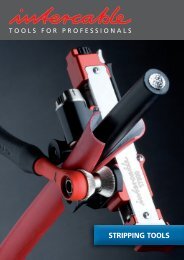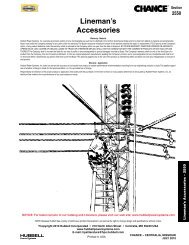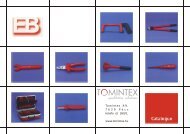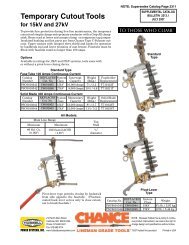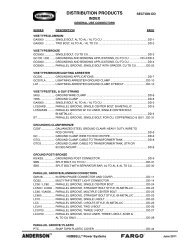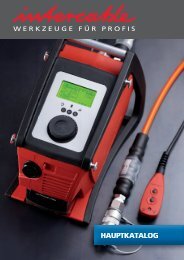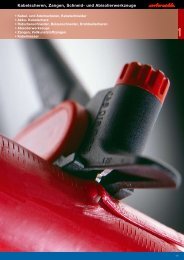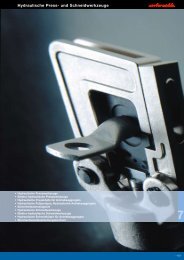Sibille Fameca Electric
Sibille Fameca Electric
Sibille Fameca Electric
You also want an ePaper? Increase the reach of your titles
YUMPU automatically turns print PDFs into web optimized ePapers that Google loves.
S t a n d a r d s a n d a d v i c e s<br />
6<br />
Standards and advices<br />
- Standards and advices -<br />
IEC 60900 - Live working – Hand tools for use up to 1 000 V a.c. and 1 500 V d.c. IEC 60 900<br />
Insulated tools standard IEC 60 900 : 2004<br />
For Low Voltage working up to :<br />
-1000 volts A.C.<br />
-1500 volts D.C.<br />
Dielectric testing Test for adhesion<br />
Indentation test<br />
Routine tests<br />
Ambient temperature impact test 23 ± 5°C : Impact of a tool falling from a height of 2 meters onto a hard surface; the test is satisfactory if the insulated layer of<br />
the tools shows no sign of a break, tear or crack.<br />
Low temperature impact test –25 °C ± 3 °C: Tools, shall be conditioned in a cooling chamber for 2 h at –25 °C ± 3 °C. The impact test shall start 120 s after<br />
removal from the cooling chamber. The ambient temperature of the test room shall be 23 °C ± 5 °C. Impact of a tool falling from a height of 0.60 meters onto a<br />
hard surface; the tests is satisfactory if the insulated layer of the tools shows no sign of a break, tear or crack.<br />
Dielectric testing : After immersion in a bath of tap water at ambient temperature for 24 hours and then dried, a test at 10kV is aplied for 3 minutes between the<br />
conductive and insulated parts. The stray current should be less than 1 mA per 200 mm of the coated tool. Test is 10 times superior to using voltage.<br />
Indentation test : After conditioning for 2 hours at 70°C, a weight of 20N being applied to the must vulnerable part of the tool, the assembly is submitted to e<br />
voltage of 5kV for 3 minutes. No perforation, energizing or bypassing should be observed during this test.Test is 10 times superior to using voltage.<br />
Test for adhesion of the insulating material coating : After conditioning for 168 hours at 70°C, a weight of 500N is applied for 3 minutes to tests the adhesion to<br />
the steel of the insulated part. For other tools, such as wrenches, the weight is 50N. Either test shall be considered as passed if the insulating material coating<br />
does not movemore than 3 mm from its initial location on the conductive part, and without any breakage ofthe insulating material.<br />
Flame retardancy test : The tool is exposed to a flame during 10 seconds. The flame is then removed and the propagation should be observed for 20 seconds. The<br />
test shall be considered as passed if the flame height on the tool does not exceed 120 mm during the 20 s of the observation period.<br />
Routine tests : Each tool is checked individually at 10kV for 10 seconds. A 100% sight check is carried out to set aside tools showing any fault in their appearance.<br />
TOOLS FOR ELECTRICIANS<br />
Insulated tools standard<br />
IEC 60 900 : 2004<br />
Flame retardancy test




